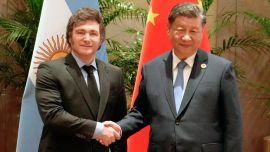When President Mauricio Macri opened Congress this year, he put gender issues firmly on the agenda, announcing that both the decriminalisation of abortion and the gender pay gap would be discussed and debated this congressional year.
Days after that speech, on International Women’s Day, the government announced a bill — which also included an extension of paternity leave — to close the gender pay gap. Lawmakers from the governing Cambiemos (Let’s Change) coalition, meanwhile, presented their own abortion bill.
Almost three months later, the issue of the gender pay gap hasn’t received remotely the same amount of attention as abortion reform, neither on the streets nor in Congress (despite the fact that Macri himself is not in favour of abortion but has described the pay gap as “unfair” and “not right.”)
As another anniversary of the first Ni Una Menos march of 2015 approaches on June 3, here’s a look into this complex issue, one which hasn’t yet managed to elbow its way into mainstream dialogue alongside thorny subjects such as gendered violence and abortion.
NUMBER-CRUNCHING
In his speech to Congress, Macri accurately said that Argentina’s gender pay gap stands at 30 percent. Most studies place it between 25 and 30 percent.
Data compiled from the third trimester of 2017 by the INDEC national statistics bureau found that women in Argentina are being paid on average 26 percent less than men in the workplace, with employed men earning an average salary of 16,733 pesos and women 12,366 pesos in urban areas. (These numbers are “unadjusted,” meaning they do not take into account age, education, job experience or other variables.) Another study by the Work Risks Superintendent’s Office breaks it down further, by economic sector, with the mining sector taking the lead with its own pay gap of 29.6 percent. In the informal or ‘black’ economy, INDEC’s Permanent Survey of Households (EPH) placed the gap at 35 percent in 2017.
Despite Argentina ranking 34th out of 144 countries in the Global Economic Forum’s “Global Gender Gap Score,” the country has starkly poorer results for “economic participation and opportunity,” coming in 111th place for that criteria. There are several potential factors here: on the one hand there’s vertical segregation, or the infamous ‘glass ceiling’ — in the private sector, there is only one female CEO and no female VPs among the top 25 Argentine companies, according to one study by Chequeado. On the other hand, horizontal segregation concentrates working women in jobs generally considered to be more ‘feminine’ — such as domestic services, health and education — which usually fall on the lower end of the salary spectrum.
This all leads to unequal representation of women in the labour market. According to INDEC, out of the 10 percent of the population that receive the lowest incomes, 6.8 percent are women. As salaries increase, the proportion of women decreases: in the 10 percent that fall highest wage bracket, 6.3 percent are men. INDEC’s gender-differentiated unemployment rate also exemplifies unequal access, revealing a female unemployment rate of 10.2 percent versus 8.5 percent for men. This disparity is also true for the Latin America and Caribbean region at large, with male and female levels of unemployment standing at 7.6 percent and 10.4 percent respectively, according to a 2017 International Labour Organisation (ILO) report.
BILLS AND ARTICLES
There are currently two gender pay gap bills that have yet to be addressed in Congress. (For a sense of perspective, the Cambiemos abortion bill was amongst seven others.)
The first was presented by a Republican Proposal (PRO) lawmaker for Buenos Aires province, Martín Medina, a full week before Macri announced the Executive’s version. In an interview with the Times, Medina said he had had no idea that the government was planning to put forward their own proposal — despite the synchronicity in time and, in some places, wording.
The main focus of Medina’s bill, his first, is to guarantee equal pay by modifying and adding to the national Contract of Employment Law (Law 20.744); specifically, to outline “gender equality in the workplace” in Article 172, which currently prohibits gender discrimination; and establish “strict salary parity,” in a new Article 173. The main takeaway is the proposed Article 173 bis, which announces ways that “those who believed or were sure that they were receiving an unequal salary to a coworker for the same job” could ask their company for the financial information to prove it. Should unequal pay be proven, “the worker may ask their employer to remedy the situation within no more than 60 days” and, if the issue is not resolved, take the issue to the Labour Ministry. A “Register of Companies and Organisations with Equal Pay” would also be created, mandatory for companies with over 200 employees, for further transparency.
Medina said that the inspiration for the bill came from the experiences of his own working mother, who had difficulties in moving up professionally due to taking care of her children. However, he explicitly told the Times that he did not want to “frame the issue in terms of men and women.” Rather, he pointed to “circumstances that people face when they begin their careers, which is employers wrongly categorising employees [in lower-paying jobs] and a lack of access to a more transparent, simple procedure to demand that companies rectify an anomalous salary payment.” Medina agreed though that women suffer from this problem more, saying it “adds up down the line.”
In terms of tackling of the gender pay gap, the criticisms of this bill are twofold.
First, the right to equal pay for equal work is already enshrined both in Article 14bis of the Constitution and within Law 20.744 itself. Furthermore, equal pay is not the same as the gender pay gap, which refers to the difference between the average of men’s and women’s earnings (which can be calculated across a company, economic sector or the entire job market). Although it does happen, the situation isn’t usually as simple or as direct as a woman being paid less than her male co-worker in the neighbouring cubicle for the exact same job, which is unconstitutional.
Thus, Medina’s bill would only address one facet of the issue, which is companies categorising jobs held by women (and, according to Medina, men at entry-level) as more junior in order to justify an unfairly lower salary. Any pay gaps that could be revealed by the proposed “register” wouldn’t necessarily correspond to violations of equal pay, either.
The second criticism is that the bill places the burden of responsibility almost solely on the employee.
“You, the working woman, have to go, look through your co-workers papers and company receipts, put a little file together and take it to the Labour Ministry. There are no sanctions set for companies: they could fire you for doing this. It’s a way of saying ‘If you didn’t realise or didn’t check properly, it’s acceptable that you are paid less,’” Dr. Mercedes D’Alessandro, the head of the Economía Feminista organisation, which highlights gender inequality through data and statistics, told the Times.
When asked about this, Medina posited that “the defence of one’s rights is always, initially, your own: if you don’t speak up, it’s hard for someone else to.” He told the Times that his mission is to “simplify processes for employees” and “repair work relations: it’s important to understand that employers are not the enemy, while making sure that they don’t overstep their power.”
THE EXECUTIVE
The “Gender Equality Bill” put forward by the government is wider in scope, but less specific in its implementation: it would modify four articles (172, 173, 175 and 176) of the aforementioned Law 20.744.
In the first chapter on equal pay and the gender pay gap, the proposals are somewhat vague and similar in language to Medina’s bill (without his proposed channel for employee complaints.) The second chapter, however, goes much further — ideas include extending paternity leave; post-natal options such as compensated leave for childcare; a “code of conduct” for companies; home-office options and days off “irrespective of the worker’s gender” for new adoptive parents, domestic violence victims, marriages and deaths. Despite being a full eight days under the ILO’s recommended 14 weeks, maternity leave is not addressed.
This bill sparked similar criticisms to Medina’s proposal: that it presents no substantial change to the preexisting constitutional right to equal pay and the lack of sanctions for non-compliance.
In response, the Union Women’s Network of Workers Corriente Federal (Mujeres Sindicalistas de la Corriente Federal de Trabajadores) and other organisations signed a document in response to the bill titled “In order to have equality, there must be guarantees,” which was presented by lawmaker Vanesa Siley (Unidad Ciudadana). They offered a series of observations and suggestions, including non-binary language to include all genders and a “complete overhaul of the leave scheme established in Law 20.744.”
Although the bill tackles broader issues that affect the gender pay gap, for D’Alessandro the government measures would still not be enough to tackle the necessary cultural shift, citing the experience of several Nordic countries that had to make paternity leave mandatory because men were simply not taking the time off. “It’s not enough to create that opportunity unless an effort is made to change that ‘chip’ dictating that men are breadwinners and mothers are caregivers — it won’t be solved by magic.”
According to D’Alessandro, “the main issue is the asymmetrical distribution of domestic chores and non-paid labour. If you look at hourly incomes in Argentina, there’s only a two-percent difference between men and women. The problem is when you look at monthly income: women with children earn much less because they work shorter days and can’t work overtime due to household duties like cleaning and childcare.”
Such issues directly impact upon female participation in the labour market. The cultural norms around motherhood often mean that they end up in underpaid jobs in a bid to find flexibility or even stop working altogether.
When asked about the major difficulties faced in addressing the gender pay gap, Medina also noted the need to share domestic duties and for men to accept changes in the “traditional” family structure and set-up. For him, modifying Articles 172 and 173 of Law 20.744 would be a significant step forward for this.
At press time, the Executive Branch had not responded to requests for comment on either of the two proposals.
LITTLE HEADWAY
Regardless of the issues of the two bills, both have made little headway to date. In fact, they have yet to be discussed in any preliminary committees.
According to Medina, the Lower House’s Labour Committee is currently addressing other issues, though he believes his equal pay legislation should be tackled within the next few weeks. He also pointed out that societal pressure is often a factor, a reference to the highly charged abortion debate.
For D’Alessandro, it’s more about government priorities than legislative calendars: “They need women to bolster this. [It’s] not that men can’t push these issues, but that Macri’s government is not centred on gender equality. Equality is just a photo taken for International Women’s Day — the photos you see afterwards are all men debating with other men.”
There are also other priorities within the feminist movement. D’Alessandro told the Times that the gender pay gap was currently “not central on the feminist agenda. It is mentioned and on the list but it’s not a concrete complaint on the street, so it’s not getting a lot of movement inside [Congress].”
D’Alessandro sees cause for optimism, though. She outlined how there have been distinct ‘seasons’ of predominant feminist issues ever since the first Ni Una Menos march — legislation on gendered violence, the 2017 50/50 law on female representation and now, the abortion debate — with each advance leading to other topics being publicly addressed further down the road.
The influx of women into the public sphere next year — when a law requiring 50 percent of political candidates to be female comes into force — could give the gender pay gap greater visibility too, raising it up the domestic agenda.
The perceived failure of the proposals to adequately capture the complexities of the gender pay gap and the overall silence aren’t necessarily a big worry, D’Alessandro argues.
“I wouldn’t give the government bill much importance per se because it’s quite limited and I don’t think it will change history. We’ll probably see more interesting ideas on this issue in future,” she said.
As tends to be the case worldwide, despite the existing legal structures in place against unequal pay, the gender pay gap persists precisely because there are structural factors behind the numbers that are often hard to quantif y and address. Although it may not be a major talking point right now, the fact that there are already bills in Congress means that there is at least a foot in the door. Even if its not the best foot that’s being put forward.


























Comments